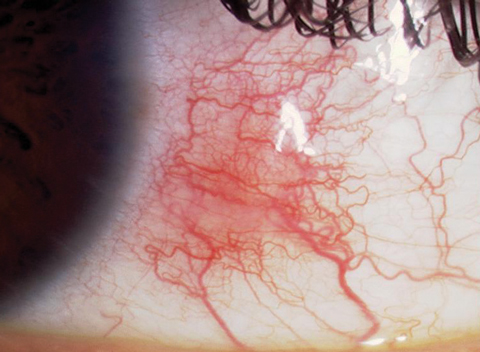 |
| Anterior segment OCT-A may be useful to evaluate the initial changes in limbal vasculature in contact lens users. Photo: Jim Williamson, OD. Click image to enlarge. |
A recent study reported that patients who wear their contact lenses overnight exhibit increased vessel density in the superficial layers of the perilimbal region, which may be associated with new vessel formation in the conjunctiva.
This observational study included 42 patients (22 overnight lens users and 20 healthy controls). The team performed OCT-A imaging in the temporal quadrant of the perilimbal region using a swept-source OCT system. The assessments were made in two depths: starting from the conjunctival epithelium to a scleral depth of 200mm and the scleral depth between 200mm and 1,000mm. The vessel density, vessel length density, vessel diameter index and fractal dimension were compared between overnight lens users and a healthy population.
The vessel density at the superficial layer was significantly higher in the lens group compared with the control group. Vessel diameter index, vessel length density and fractal dimension at the superficial layer did not differ between the groups. There was no difference in the vessel density, vessel diameter index, vessel length density and fractal dimension in the deep layer between the groups.
“Anterior segment OCT-A may be useful to evaluate the initial changes in limbal vasculature in contact lens users,” the study authors concluded.
Ceran BB, Ozates S, Arifoglu HB, et al. Changes in limbal optical coherence tomography angiography outcomes in patients with overnight contact lens wear. Eye Contact Lens. October 1, 2021. [Epub ahead of print]. |

